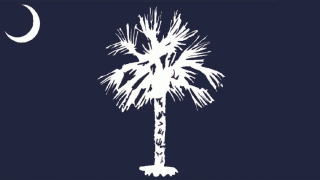
The proposed new design for South Carolina's state flag began circulating online late last month, and the social media reaction lacked any Southern niceties.
The tentative design included a crescent and palmetto tree, the official state tree, on an indigo background, similar to the current but nonstandardized versions that manufacturers sell. The new version was approved by a committee of historians and politicians, but the tree, in particular, did not appeal to many state residents. It even drew comparisons to the Charlie Brown Christmas tree, hurricane wreckage and a toilet brush, according to local paper The Post & Courier. The outlet did an unofficial Twitter poll and found that only 22% of respondents approved.
"Just saw someone describe the palmetto tree on the potential new state flag of South Carolina as a toilet bowl brush. I think I died from laughter," wrote one Twitter user.
"How can you screw up one of the greatest state flags in American history? Well, this South Carolina 'historical commission' somehow found a way to do it," added another.
Get Philly local news, weather forecasts, sports and entertainment stories to your inbox. Sign up for NBC Philadelphia newsletters.
TODAY's Craig Melvin, a South Carolina native, also has some concerns about the new design.
"Ours is undeniably one of the top three flags in America in popularity ... and historical significance," he said via email. "Flags are supposed to unite all who live under them. One thing is clear, this new proposed design has united all true South Carolinians in their collective disgust and confusion. If it ain’t broke ..."
Since the 1800s, the state's flag has featured a crescent and palmetto tree on a blue background, but there has not been a standardized flag since 1940, when the most recent standardized design was repealed. As a result, current depictions of the state flag vary from manufacturer to manufacturer.
U.S. & World
Stories that affect your life across the U.S. and around the world.
In late 2018, the flag commission met for the first time with the goal of creating a flag that can be used in an official government capacity, and in March 2020 it unveiled its final design. The online backlash began when The Post & Courier shared the tentative new version in an article late last month.
All three of the new version's primary elements — the crescent, color and tree — have prominent significance in the state's history, Eric Emerson, director of the state's department of archives and history, who sits on the flag committee, told TODAY. The indigo background and the crescent both come from the oldest surviving regimental flag of South Carolina from the Revolutionary War. The committee knew, however, that the palmetto would be the most "tricky" to navigate, Emerson said.
"There are innumerable examples of historic palmettos," Emerson explained. "No two are alike."
As a result, the committee chose one based on the artwork of Ellen Heyward Jervey, an amateur artist and librarian from Charleston, South Carolina. She shared her depictions of the palmetto with the creator of the 1910 version of the flag, which was used until 1940.
The response hasn't been universally negative, Emerson stressed.
"I don't anticipate anything from Twitter or any other form of social media but negativity," he said. "No one ever tweets, 'That's the most beautiful thing I've ever seen.' ... Any new design, I anticipate the same kind of response on social media."
He added that he's received plenty of emails with positive feedback and "constructive criticism," often questions about why the palmetto looks so different from what South Carolinians are used to seeing.
"I explain, 'Well, manufacturers created those, and they're not really historic.' ... We don't know where they came from," Emerson said.
So what's next for the Palmetto State's flag? Other outlets have reported that Emerson's committee's design is scrapped, but that's not exactly true, Emerson said. He anticipates that the state's general assembly is going to ask to see at least one alternative design, and if that's the case, the department of history and archives has a few ready to go, he said.
"We can find a historic palmetto that looks closer to what (people have) seen before," Emerson said. "I think that's the issue. People just want to see something that's not too different, too dramatic of a change from what they've seen."
This story first appeared on TODAY.com. More from TODAY:



